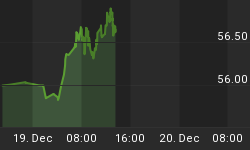In hindsight, the best strategy has been to "set it and forget it" - buy at the bottom in March, 2009 and let it ride. I am sure that is what everyone did! Going forward, the best strategy remains as it has been since October. It will be important to exercise patience and buy at the lows and sell at the highs to capture any profits from this market. While buying low and selling high is always a good policy, it is particularly important here. Extremes in bullish sentiment, as we are seeing now, imply that a price move is either nearing its end or the ascent of prices is surely to show. This is our expectation 85% of the time. The other 15% of the time or what I like to call "it takes bulls to make a bull market" scenario, the market will continue meaningfully higher despite increasing bullish sentiment. We saw this in 1995, 2003, and 2009 when the markets were coming off of long periods of under performance. I am not banking on this time being different.
As an example, just think about the last time "everyone was all in" and the market was going to the moon. Let's see, that was the first week of January, 2010. On January 8 the S&P500 closed 1145. This past week the S&P500 made a marginal new high at 1159. To make that 1.2% over the past 9 weeks, you had to endure about a 7% draw down or loss first. In my opinion, that's the path to the poor house - not the end of the rainbow.
And now this from the Department of Broken Records....
The "Dumb Money" indicator, which is shown in figure 1, looks for extremes in the data from 4 different groups of investors who historically have been wrong on the market: 1) Investor Intelligence; 2) Market Vane; 3) American Association of Individual Investors; and 4) the put call ratio. The "Dumb Money" indicator has turned bullish to an extreme degree.
Figure 1. "Dumb Money" Indicator/ weekly
The "Smart Money" indicator is shown in figure 2. The "smart money indicator is a composite of the following data: 1) public to specialist short ratio; 2) specialist short to total short ratio; 3) SP100 option traders. The Smart Money indicator is neutral.
Figure 2. "Smart Money" Indicator/ weekly
Figure 3 is a weekly chart of the S&P500 with the InsiderScore "entire market" value in the lower panel. From the InsiderScore weekly report we get the following: 1) "Sellers Continue Domination"; 2) "Our Weekly Score moved ever so slightly off its three-year low"; 3) "Insider selling at small- and mid-cap companies increased".
Figure 3. InsiderScore Entire Market/ weekly
Figure 4 is a weekly chart of the S&P500. The indicator in the lower panel measures all the assets in the Rydex bullish oriented equity funds divided by the sum of assets in the bullish oriented equity funds plus the assets in the bearish oriented equity funds. When the indicator is green, the value is low and there is fear in the market; this is where market bottoms are forged. When the indicator is red, there is complacency in the market. There are too many bulls and this is when market advances stall.
Currently, the value of the indicator is 63.41%. Values greater than 58% (arbitrarily chosen) are associated with market tops, and the red dots over the price bars indicate such. Tthe value can go higher, mind you, as there was a 66% reading in 2005. During that time when the indicator hit 58% the S&P500 was at 1184; 8 weeks later the indicator hit 66% and the S&P500 hit a high of 1217. In addition, it has been my contention that the dip buyers bought the dip too early, and in all likelihood, they will be disappointed (unless they are selling now) as it will take lower prices to bring about a more lasting bottom and tradeable rally.
Shorter term Rydex measures continue to suggest excessive bullishness as these market timers have been warming up to higher prices over the past week. This data, which has proved to be very actionable, is now available for a nominal yearly fee as Premium Content. This service should help you to improve your market timing!
Figure 4. Rydex Total Bull v. Total Bear/ weekly















